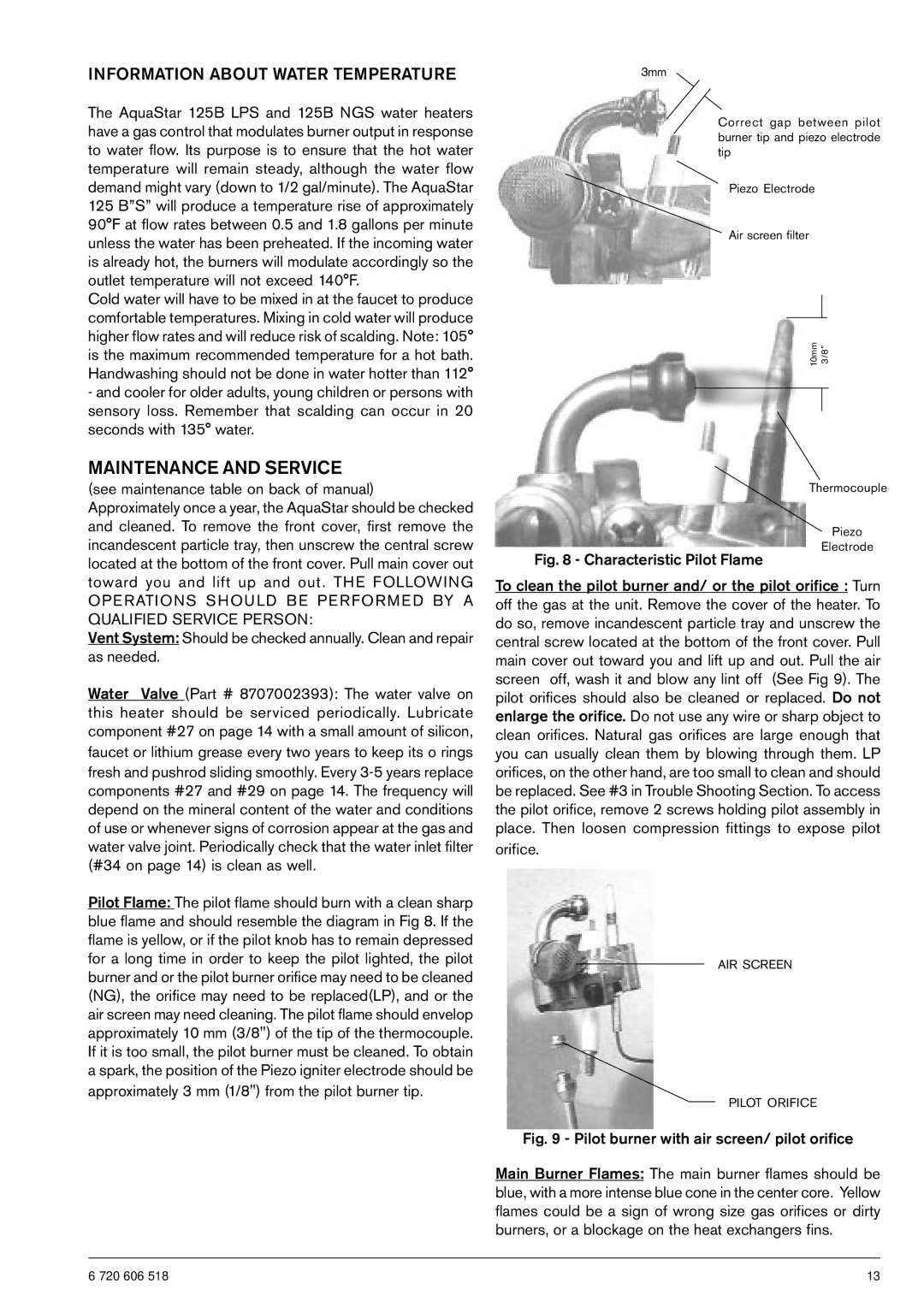
INFORMATION ABOUT WATER TEMPERATURE
The AquaStar 125B LPS and 125B NGS water heaters have a gas control that modulates burner output in response to water flow. Its purpose is to ensure that the hot water temperature will remain steady, although the water flow demand might vary (down to 1/2 gal/minute). The AquaStar 125 B”S” will produce a temperature rise of approximately 90°F at flow rates between 0.5 and 1.8 gallons per minute unless the water has been preheated. If the incoming water is already hot, the burners will modulate accordingly so the outlet temperature will not exceed 140°F.
Cold water will have to be mixed in at the faucet to produce comfortable temperatures. Mixing in cold water will produce higher flow rates and will reduce risk of scalding. Note: 105° is the maximum recommended temperature for a hot bath. Handwashing should not be done in water hotter than 112°
-and cooler for older adults, young children or persons with sensory loss. Remember that scalding can occur in 20 seconds with 135° water.
MAINTENANCE AND SERVICE
(see maintenance table on back of manual)
Approximately once a year, the AquaStar should be checked and cleaned. To remove the front cover, first remove the incandescent particle tray, then unscrew the central screw located at the bottom of the front cover. Pull main cover out toward you and lift up and out . TH E FOLLOWI NG OP E RATION S SHOU LD B E PE R FOR M E D BY A QUALIFIED SERVICE PERSON:
Vent System: Should be checked annually. Clean and repair as needed.
Water Valve (Part # 8707002393): The water valve on this heater should be serviced periodically. Lubricate component #27 on page 14 with a small amount of silicon, faucet or lithium grease every two years to keep its o rings fresh and pushrod sliding smoothly. Every
Pilot Flame: The pilot flame should burn with a clean sharp blue flame and should resemble the diagram in Fig 8. If the flame is yellow, or if the pilot knob has to remain depressed for a long time in order to keep the pilot lighted, the pilot burner and or the pilot burner orifice may need to be cleaned (NG), the orifice may need to be replaced(LP), and or the air screen may need cleaning. The pilot flame should envelop approximately 10 mm (3/8") of the tip of the thermocouple. If it is too small, the pilot burner must be cleaned. To obtain a spark, the position of the Piezo igniter electrode should be approximately 3 mm (1/8") from the pilot burner tip.
3mm
Correct gap between pilot burner tip and piezo electrode tip
Piezo Electrode
Air screen filter
10mm | 3/8” |
|
|
|
|
Thermocouple
Piezo
Electrode
Fig. 8 - Characteristic Pilot Flame
To clean the pilot burner and/ or the pilot orifice : Turn off the gas at the unit. Remove the cover of the heater. To do so, remove incandescent particle tray and unscrew the central screw located at the bottom of the front cover. Pull main cover out toward you and lift up and out. Pull the air screen off, wash it and blow any lint off (See Fig 9). The pilot orifices should also be cleaned or replaced. Do not enlarge the orifice. Do not use any wire or sharp object to clean orifices. Natural gas orifices are large enough that you can usually clean them by blowing through them. LP orifices, on the other hand, are too small to clean and should be replaced. See #3 in Trouble Shooting Section. To access the pilot orifice, remove 2 screws holding pilot assembly in place. Then loosen compression fittings to expose pilot orifice.
AIR SCREEN
PILOT ORIFICE
Fig. 9 - Pilot burner with air screen/ pilot orifice
Main Burner Flames: The main burner flames should be blue, with a more intense blue cone in the center core. Yellow flames could be a sign of wrong size gas orifices or dirty burners, or a blockage on the heat exchangers fins.
6 720 606 518 | 13 |
